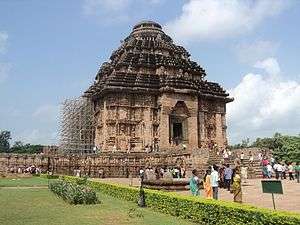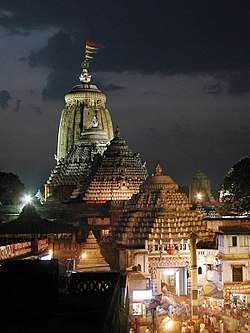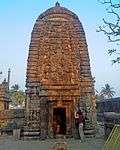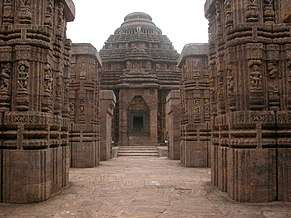Eastern Ganga dynasty
The Eastern Ganga dynasty also known as Rudhi Gangas or Prachya Gangas were a medieval Indian dynasty that reigned from Kalinga from as early as the 5th century to the early 15th century. The territory ruled by the dynasty consisted of the whole of the modern-day Indian state of Odisha as well as parts of West Bengal, Andhra Pradesh and Chhattisgarh.[1] The early rulers of the dynasty ruled from Dantapura; the capital was later moved to Kalinganagara (modern Mukhalingam), and ultimately to Kataka (modern Cuttack).[2] Today, they are most remembered as the builders of the world renounced Puri Jagannath Temple and Konark Sun Temple, a UNESCO World Heritage site at Konark, Odisha.
Eastern Ganga Empire | |||||||||
|---|---|---|---|---|---|---|---|---|---|
| 1078–1434 | |||||||||
| Capital | Dantapura Kalinganagara Kataka | ||||||||
| Religion | Hinduism | ||||||||
| Government | Monarchy | ||||||||
| Tri-Kalingadhipati | |||||||||
• 980–1015 | Vajrahasta Aniyankhabhima | ||||||||
• 1038–1070 | Vajrahasta Anantavarman | ||||||||
• 1070-1078 | Rajaraja Devendravarman | ||||||||
• 1078–1147 | Anantavarman Chodagangadeva | ||||||||
• 1178–1198 | Ananga Bhima Deva II | ||||||||
• 1238–1264 | Narasingha Deva I | ||||||||
• 1414–1434 | Bhanu Deva IV | ||||||||
| Historical era | Classical India | ||||||||
• Established | 1078 | ||||||||
• Disestablished | 1434 | ||||||||
| |||||||||

The rulers of Eastern Ganga dynasty defended their kingdom from the constant attacks of the Muslim rulers. This kingdom prospered through trade and commerce and the wealth was mostly used in the construction of temples. The rule of the dynasty came to an end under the reign of King Bhanudeva IV (1414–34), in the early 15th century.[3] Their currency was called Ganga fanams and was similar to that of the Cholas and Eastern Chalukyas of southern India.[4]
Origin
The origin of the Later Eastern Gangas is not clearly established.[5] It is erratically summarized that they were an offshoot of the Western Ganga dynasty who were a south Indian dynasty but there is no evidence of architectural, linguistic and patterns of nomenclature of the kings having similarity between the Ganga kings of Karnataka and that of Odisha.[6] Also, while the bardic traditions of the Western Ganga dynasty claim descent from the Sun through the Ikshavaku dynasty, the Eastern Ganga genealogies ascribe descent from the Moon; the Chandravamsa lineage. Unlike the Western Ganga Dynasty who traced their lineage to the Solar Dynasty,[7] the Later Eastern Gangas claimed a lunar descent from Vishnu through Brahma, Atri and Chandra (moon).[8] The Eastern Ganga king Indravarman III in his Andhavaram copperplate inscription has mentioned that the Gangas are described as the descendants of the Tumbura dynasty. In the Vayu Purana references are made that at the foothills of the Vindhyas, there was a Janapada named Tumura, Tumbura. Odia historian Jagabandhu Singh citing references from Padma Purana and Brahmavaibarta Purana has identified Tumbura being ruled by the Mahisya race of Khshetriyas who were maritally either related to the Kaivartta community or were born from marriages between Khsetriyas and Vaishya women. Basically he theorized that they originated from the Vindhyas and foothills of the river Narmada.
Similarly Bengali historian Sevanand Bharati has theorised that this Mahisya community migrated towards south from the banks of river Sarayu in Ayodhya and entered Medinapur region of today's West Bengal in the Sakabda year 822. In the Census Report, 1891 of Midnapur district of Ancient Kalinga, there is mention of the history of this Kaivartta or Mahishya race: “The Kaivarttas are probably an offshoot of a race or tribe whose original seat was in the upcountry”. Further Bengali historians like Pandit Lalmohan Vidyanidhi in his book Sambandha Nirnaya and Mahima Ch. Mazumdar in his book Gaude Brahmana have mentioned that the Mahisya-race became very powerful and were later divided into four divisions, like Aswapati, Gajapati, Narapati and Chhatrapati. The Gajapatis had established their empire in Odisha. Initially the five leaders who led them to this region in the farthest limits of the eastern India from Ayodhya had established five small kingdoms (1) Tamralipta or Tamluk, (2) Balisita or Mainagarh, (3) Turkee or Turka, (4) Sujamutha, (5) Kutabpur.[9] Agreeing to this, Sir Harbert Risley has mentioned in his book “Tribes and castes of Bengal” that they have five princedoms in the Midnapur district. Sevananda Bharati has mentioned that the ancient Tamralipta or modern Tamluk is the first settlement of the Gangas. Historian N.N. Basu, who has translated the inscriptions of the imperial Gangas has mentioned that the first Ganga king Ananta-varman and his descendants, who ruled over Gangabada or Gangabadi were also called Rudhi Ganga. This theory is also accepted by Odia historians like Dr. Harekrushna Mahatab. Also, Dr. Nabin Kumar Sahu states “Probably the primary abode of the Gangas is that region, which is described as Gangaridai by Meghasthenes.” This region shown in the maps of that period can be identified with the coastal region of river Ganges along with modern Midnapur. Gangaridai has been derived from the word Gangaradhi. Jagabandhu Singh has mentioned in his book Prachina Utkal that some Bengali historians are of opinion that Gangabadi, the name mentioned in Vizagpattnam and Komi copperplate inscriptions of Chodaganga Deva is a derivative of Gangaradhi the word radhi or rudhi was applied to the Kaivarttas who inhabited the entire east coast region stretching from the mouth of river Ganges to the river Godavari in the South.
Five prominent dominions of the Kalingan Prachya Ganga family are identified from five different administrative centers namely - Kalinganagara (Srikakulam), Svetaka Mandala (Ganjam), Giri Kalinga (Simhapur), Ambabadi Mandala (Gunupur, Rayagada) and Vartanni Mandala (Hinjilikatu, Ganjam) . The heartland of the Prachya Gangas had three parts of Kalinga namely, Daksina Kalinga (Pithapura), Madhya Kalinga (Yellamanchili Kalinga or Visakhapatnam) and Uttara Kalinga (districts of Srikakulam, Ganjam, Gajapati and Rayagada).The earliest known prominent king was Indravarman who is known from his Jiringi copper plate grant. The Godavari grant of Raja Prthivimalla and the Ramatirtham grant of Vishnukundina king Indrbhattaraka refer to a war of four tusked elephants or Chaturdanta Samara in which Indravarman I the son of Mitavarman, a Ganga general of Vakataka king and a local ruler of Dantapura commanded an alliance of small South Kalingan kingdoms against the powerful Vishnukundina king Indrabhattaraka, defeated and killed him.[10] The Vishnukundins returned with a vengeance, defeated the Vakataka King and members of the alliance while Indravarman declared himself as Tri-Kalingadhipati (the lord of the three Kalingas) rising from obscurity and moving his capital northwards away from the attacking Vishnukundins. His son Hastivarman found himself stuck between two Gupta feudal dynasties of Odisha, the Vigrahas of South Toshali and Mudgalas. Joining the onslaught like his father, he commanded major battles against the Vigrahas and won territories in the northern parts of ancient Kalinga and declared himself as Sakala-Kalingadhipati (the ruler of whole Kalinga). The dynasty though remaining to be a strong ruling family in ancient Odisha and North Andhra Pradesh continued to remain as vassal rulers under the central authority of the Bhauma-Kara dynasty which is proven by the fact that a smaller Eastern Ganga king belonging to the clan and named as Jayavarmadeva mentioned himself as the vassal of Sivakara Deva I in his Ganjam grant and by whose permission he gave away the grants.
It was during the rule of Anantavarman Vajrahasta V in the mid eleventh century that the clan started emerging as a major military power challenging the authority of the Somavanshi Dynasty at their northern frontiers and allying with their arch rivals the Kalchuris. After a series of victories in battle and making land grants to three hundred Brahmin families in his kingdom, Vajrahasta V assumed the titles as Trikalingadhipati (lord of the three Kalingas) and Sakalakalingadhipati (lord of complete Kalinga) challenging the centralized authority of the Somavanshis and laying the foundation to an imperial era for the Eastern Gangas. In the later years of the century, Devendravarman Rajaraja I defeated the Somavanshi king Mahasivagupta Janmenjaya II completely while challenging the Cholas in battle, along with establishing authority in the Vengi region.The Cholas were defeated by Rajaraja I and Chola princess, Rajasundari, was married off to the Eastern Ganga king as a goodwill gesture for settlement of affairs between the Cholas and the Gangas.[11] The identification of the father of Rajasundari is a matter of great controversy and some scholars like K. A. Nilakanta Sastri identify the king as Virarajendra Chola.[12][13] After the sudden death of Rajaraja I, his underage sons Chodaganga Deva ascended the throne, losing the many parts of his ancestral kingdom to the Cholas who were now in an advantageous position. However, Ananatavarman Chodaganga Deva not only lived a young life of prolonged struggles and setbacks but finally managed to completely rout the Chola presence from the region and finally securing Utkala, Kalinga, Gauda, Radha and Vengi as one kingdom. While many of his inscriptions are found inside the limits of former Vengi kingdom, this large extent of his empire from Bengal to Vengi is clearly stated in his Korni grant inscriptions.[14][15] In the Sri Kurmam temple grant of Chodaganga, it is clearly stated that he has extended his territory from Bhagirathi Ganga to Gautami Ganga rivers which literally the region between river Ganga and Godavari.[16] The only front where he faced setbacks is against his western rivals the Kalachuris where he was unsuccessful. His descendant Anangabhima Deva III gradually completed the task of defeating the Kalachuris completely. In his Korni copper plate grant he mentions himself to be the lord of 99,000 war elephants which while counting military strength according to the ancient Gulma system of military divisions, puts his strength to a million men and half a million animals employed to his command. Due to his maternal relation with the Cholas, a Chola uncle of Chodaganga by the name Virachoda had sided by him as a protective guardian against the invading Cholas since his childhood. Chodaganga was married to the daughter of this uncle and also had Tamil officers serving him during his lifelong affairs of war and administration.[17] Chodaganga Deva not only reunited most of ancient Kalinga stretching from the rivers Ganga to Godavari but led the foundation to the imperial hegemony of the Eastern Gangas in the Eastern coast of India. Chodaganga Deva was a strong king and was the son of Rajaraja Devendravarman and grandson of Vajrahasta Anantavarman of the Imperial Gangas of Kalinganagara.[18][19][20] His mother was princess Rajasundari of the Chola dynasty.[21]
Background
After the fall of Mahameghavahana dynasty, Kalinga was divided into different kingdoms under feudatory chiefs. Each of these chiefs bore the title Kalingadhipathi (Lord of Kalinga). The beginnings of what became the Eastern Ganga dynasty came about when Indravarma I defeated the Vishnukundin king, Indrabhattaraka and established his rule over the region with Kalinganagara (or Mukhalingam) as his capital, and Dantapura as a secondary capital. The Ganga kings assumed various titles viz. Trikalingadhipathi or Sakala Kalingadhipathi (Lord of three Kalinga or all three Kalingas namely Kalinga proper (South), Utkala (North), and Kosala (West)).
Mukhalingam near Srikakulam of Andhra Pradesh bordering Odisha has been identified as Kalinganagara, the capital of the early Eastern Gangas.[22]
After the decline of the early Eastern Gangas reign, the Chalukyas of Vengi took control of the region. The first monarch of the dynasty Vajrahastha Aniyakabhima I (980-1015 A.D), took advantage of the internal strife and revived the power of the Ganga dynasty. It was during their rule that Shaivism took precedence over Buddhism and Jainism. The magnificent Srimukhalingam Temple at Mukhalingam was built during this period.
In the 11th century, the Cholas brought the Ganga Kingdom under their rule with the sudden death of Devendravarman Rajraja I.[22] His son Chodaganga Deva who ascended the throne at the age of five under the protection provide by one of his maternal uncles from the Chola family had to overcome multiple obstacles before securing Kalinga, Vengi, Utkala, Odra and parts of Bengal as one kingdom.
Intermarriage
The Eastern Gangas were known to have intermarried with the Parmaras, Cholas, Chalukyas. The early state of the dynasty may have started from the early 8th century.
Anantavarman Chodaganga

The dynasty, towards the end of eleventh century came to be known as Chodaganga dynasty after its founder Anantavarman Chodaganga. He is believed to have ruled from the Ganges River in the north to the Godavari River in the south, thus laying the foundation of the Eastern Ganga Dynasty. Also during his rule, the great Jagannath Temple at Puri was built.[22] He assumed the title of Trikalingadhipathi (ruler of the three Kalingas which comprise Kalinga proper, Utkala north and Koshala west) in 1076 CE, resulting in him being the first to rule all three divisions of Kalinga.[23]
Anantavarman was a religious person as well as a patron of art and literature. He is credited for having built the famous Jagannath Temple of Puri in Odisha.[23] King Anantavarman Chodagangadeva was succeeded by a long line of illustrious rulers such as Narasingha Deva I (1238–1264).
Intrudes
Rajaraja III ascended the throne in 1198 and did nothing to resist the Muslims of Bengal, who invaded Orissa in 1206. Rajaraja's son Anangabhima III, however, repulsed the Muslims and built the temple of Megheshvara at Bhuvaneshvara. Narasimhadeva I, the son of Anangabhima, invaded southern Bengal in 1243, defeated its Muslim ruler, captured the capital (Gauda), and built the Sun Temple at Konark to commemorate his victory. With the death of Narasimha in 1264, the Eastern Gangas began to decline; the sultan of Delhi invaded Odisha in 1324, and Musunuri Nayaks defeated the Odishan powers in 1356. Narasimha IV, the last known king of the Eastern Ganga dynasty, ruled until 1425. The "mad king," Bhanudeva IV, who succeeded him, left no inscriptions; his minister Kapilendra usurped the throne and founded the Suryavamsha dynasty in 1434–35.
Legacy
The Eastern Gangas were great patrons of religion and the arts, and the temples of the Ganga period rank among the masterpieces of Kalinga and Hindu architecture.[24]
Rulers
- Mittavarman, a vassal Eastern Ganga king under Vakataka rule (c. ?-?)
- Indravarman I (496–535)[22]
- Samantavarman (537-562)
- Hastivarman (562-578)
- Indravarman II (578-589)
- Danarnava (589-652)
- Indravarman III (589-652)
- Gunarnava (652-682)
- Devendravarman I (652-682?)
- Anantavarman III (808-812?)
- Rajendravarman II (812-840?)
- Devendravarman IV (893-?)
- Devendravarman V (885-895?)
- Gunamaharnava I (895-939?)
- Vajrahasta II (or Anangabhimadeva I) (895-939?)
- Gundama - (939-942)
- Kamarnava I (942-977)
- Vinayaditya (977-980)
- Vajrahasta Aniyakabhima (980-1015 AD)[25]
- Vajrahasta Anantavarman or Vajrahasta V (1038-?)
- Rajaraja Devendravarman or Rajaraja Deva I(?-1078)
- Anantavarman Chodaganga (1078–1150)[22]
- Jateswara Deva or Ekajata Deva (1147-1156)
- Raghava Deva (1156-1170)
- Rajaraja Deva II (1170-1178)
- Ananga Bhima Deva II (1178–1198)
- Rajaraja Deva III (1198–1211)
- Ananga Bhima Deva III (1211–1238)
- Narasimha Deva I (1238–1264)[22]
- Bhanu Deva I (1264–1279)
- Narasimha Deva II (1279–1306)[22]
- Bhanu Deva II (1306–1328)
- Narasimha Deva III (1328–1352)
- Bhanu Deva III (1352–1378)
- Narasimha Deva IV (1379–1424)[22]
- Bhanu Deva IV (1424–1434)
Gallery
| Outline of South Asian history | ||||||||||||||||||||||||||||||||||||||||||||
|---|---|---|---|---|---|---|---|---|---|---|---|---|---|---|---|---|---|---|---|---|---|---|---|---|---|---|---|---|---|---|---|---|---|---|---|---|---|---|---|---|---|---|---|---|
_without_national_boundaries.svg.png) | ||||||||||||||||||||||||||||||||||||||||||||
|
Palaeolithic (2,500,000–250,000 BC) |
||||||||||||||||||||||||||||||||||||||||||||
|
Neolithic (10,800–3300 BC)
|
||||||||||||||||||||||||||||||||||||||||||||
|
Chalcolithic (3500–1500 BC)
|
||||||||||||||||||||||||||||||||||||||||||||
|
Bronze Age (3300–1300 BC)
|
||||||||||||||||||||||||||||||||||||||||||||
|
Iron Age (1500–200 BC)
|
||||||||||||||||||||||||||||||||||||||||||||
|
Middle Kingdoms (230 BC – AD 1206) |
||||||||||||||||||||||||||||||||||||||||||||
|
Late medieval period (1206–1526)
|
||||||||||||||||||||||||||||||||||||||||||||
|
Early modern period (1526–1858)
|
||||||||||||||||||||||||||||||||||||||||||||
|
Colonial states (1510–1961)
|
||||||||||||||||||||||||||||||||||||||||||||
|
Periods of Sri Lanka
|
||||||||||||||||||||||||||||||||||||||||||||
|
National histories |
||||||||||||||||||||||||||||||||||||||||||||
|
Specialised histories
|
||||||||||||||||||||||||||||||||||||||||||||
 A Temple in Sri Mukhalingam temple complex
A Temple in Sri Mukhalingam temple complex Konark Sun Temple at Konark, Odisha, built by King Narasimhadeva I (1238–1264),[22] it is now a World Heritage Site.
Konark Sun Temple at Konark, Odisha, built by King Narasimhadeva I (1238–1264),[22] it is now a World Heritage Site. A Stone carved throne at Simhachalam temple
A Stone carved throne at Simhachalam temple A Fanam (Coin) of Eastern Ganga Dynasty[26]
A Fanam (Coin) of Eastern Ganga Dynasty[26]
See also
- Western Ganga Dynasty
References
- Ganga Dynasty britannica.com. Archived 10 November 2007 at the Wayback Machine
- B. Hemalatha (1991). Life in medieval northern Andhra. Navrang.
- Archived 10 April 2009 at the Wayback Machine
- Patnaik, Nihar Ranjan (1 January 1997). Economic History of Orissa. Indus Publishing. p. 93. ISBN 978-81-7387-075-0. Retrieved 16 February 2015.
- B. Masthanaiah. The Temples of Mukhalingam: A Study on South Indian Temple Architecture. Cosmo Publications, 1977 - Mukhalingām (India) - 136 pages. p. 5.
- Singh, Dineshwar (1973). THE HISTORY OF THE EASTERN GANGA DYNASTY, CIRCA 1038 - 1238 A .D (PDF). London: University of London. pp. 55, 56, 57, 58.
- N. Venkata Ramanayya. Social and cultural life of the eastern Chalukyas of Vengi. [A.P.] Maulana Abul Kalam Azad Oriental Research Institute - Andhra Pradesh (India) - 96 pages. p. 83.
- Jörn Rüsen. Time and History: The Variety of Cultures. Berghahn Books, 01-Jan-2008 - History - 262 pages. p. 72.
- Kanungo, Dr. Harihar (2 March 2020). "The Origin of Ganga Dynasty – A New Insight" (PDF). www.magazines.odisha.gov.in. XLVII: 16, 17, 18.
- "Chapter VI, Setback and Recovery" (PDF). www.shodhganga.inflibnet.ac.in. pp. 238, -248. Retrieved 25 February 2020.
- Banarjee, R.D (1930). History Of Orissa Vol. 1. 120-2, Upper Circular Road, Calcutta: Prabasi Press. pp. 247, 248.CS1 maint: location (link)
- Tripat Sharma. Women in Ancient India, from 320 A.D. to C. 1200 A.D. Ess Ess Publications, 1987. p. 142.
- Kallidaikurichi Aiyah Nilakanta Sastri. History of India, Volume 1. S. Viswanathan, 1953. p. 247.
- Das, Manmatha Nath (1949). Glimpses Of Kalinga History. Calcutta: Century Publishers. pp. 164, 165, 166, 167, 168, 169, 170, 171.
- Rajaguru, Satyanarayan (1961). Inscriptions of Orissa, Volume III, Part II. Bhubaneswar: Orissa Sahitya Akademi. pp. 391, 392, 393.
- Rajaguru, Satyanarayan (1960). Inscriptions of Orissa, Volume III, Part I. Bhubaneswar: Orissa Sahitya Akademi. pp. 174, 175.
- Das, Dr. Manas Kumar (12 August 2017). "History of Odisha (From Earliest Times to 1434 A.D.)". DDCE/History (M.A)/SLM/Paper: 100, 101.
- Itihas, Volumes 19-22. p. 14.
- Andhra Historical Research Society, Rajahmundry, Madras. Journal of the Andhra Historical Society, Volumes 6-7. Andhra Historical Research Society., 1931. p. 200.CS1 maint: multiple names: authors list (link)
- Indian Research Institute. Indian Culture: Journal of the Indian Research Institute, Volume 12. I.B. Corporation, 1984. p. 159.
- Indian Research Institute. Indian Culture: Journal of the Indian Research Institute, Volume 12. I.B. Corporation, 1984. p. 160.
- Sen, Sailendra (2013). A Textbook of Medieval Indian History. Primus Books. pp. 36–37. ISBN 978-93-80607-34-4.
- Eastern Ganga Dynasty in India. India9.com (2005-06-07). Retrieved on 2013-07-12.
- Ganga dynasty (Indian dynasties) - Encyclopædia Britannica. Britannica.com. Retrieved on 2013-07-12.
- Sailendra Nath Sen. Ancient Indian History and Civilization. New Age International, 1999 - India - 668 pages. p. 437.
- Michael Mitchiner (1979). Oriental Coins & Their Values : Non-Islamic States and Western Colonies A.D. 600-1979. Hawkins Publications. ISBN 978-0-904173-18-5.
External links
| Wikimedia Commons has media related to Eastern Ganga Dynasty. |
| Timeline and cultural period |
Northwestern India (Punjab-Sapta Sindhu) |
Indo-Gangetic Plain | Central India | Southern India | ||
| Upper Gangetic Plain (Ganga-Yamuna doab) |
Middle Gangetic Plain | Lower Gangetic Plain | ||||
| IRON AGE | ||||||
| Culture | Late Vedic Period | Late Vedic Period (Srauta culture)[lower-alpha 1] Painted Grey Ware culture |
Late Vedic Period (Shramanic culture)[lower-alpha 2] Northern Black Polished Ware |
Pre-history | ||
| 6th century BC | Gandhara | Kuru-Panchala | Magadha | Adivasi (tribes) | ||
| Culture | Persian-Greek influences | "Second Urbanisation" Rise of Shramana movements Jainism - Buddhism - Ājīvika - Yoga |
Pre-history | |||
| 5th century BC | (Persian conquests) | Shaishunaga dynasty | Adivasi (tribes) | |||
| 4th century BC | (Greek conquests) | Nanda empire | ||||
| HISTORICAL AGE | ||||||
| Culture | Spread of Buddhism | Pre-history | Sangam period (300 BC – 200 AD) | |||
| 3rd century BC | Maurya Empire | Early Cholas Early Pandyan Kingdom Satavahana dynasty Cheras 46 other small kingdoms in Ancient Thamizhagam | ||||
| Culture | Preclassical Hinduism[lower-alpha 3] - "Hindu Synthesis"[lower-alpha 4] (ca. 200 BC - 300 AD)[lower-alpha 5][lower-alpha 6] Epics - Puranas - Ramayana - Mahabharata - Bhagavad Gita - Brahma Sutras - Smarta Tradition Mahayana Buddhism |
Sangam period (continued) (300 BC – 200 AD) | ||||
| 2nd century BC | Indo-Greek Kingdom | Shunga Empire Maha-Meghavahana Dynasty |
Early Cholas Early Pandyan Kingdom Satavahana dynasty Cheras 46 other small kingdoms in Ancient Thamizhagam | |||
| 1st century BC | ||||||
| 1st century AD | Kuninda Kingdom | |||||
| 2nd century | Kushan Empire | |||||
| 3rd century | Kushano-Sasanian Kingdom | Kushan Empire | Western Satraps | Kamarupa kingdom | Kalabhra dynasty Pandyan Kingdom (Under Kalabhras) | |
| Culture | "Golden Age of Hinduism"(ca. AD 320-650)[lower-alpha 7] Puranas Co-existence of Hinduism and Buddhism | |||||
| 4th century | Kidarites | Gupta Empire Varman dynasty |
Kalabhra dynasty Pandyan Kingdom (Under Kalabhras) Kadamba Dynasty Western Ganga Dynasty | |||
| 5th century | Hephthalite Empire | Alchon Huns | Kalabhra dynasty Pandyan Kingdom (Under Kalabhras) Vishnukundina | |||
| 6th century | Nezak Huns Kabul Shahi |
Maitraka | Adivasi (tribes) | Badami Chalukyas Kalabhra dynasty Pandyan Kingdom (Under Kalabhras) | ||
| Culture | Late-Classical Hinduism (ca. AD 650-1100)[lower-alpha 8] Advaita Vedanta - Tantra Decline of Buddhism in India | |||||
| 7th century | Indo-Sassanids | Vakataka dynasty Empire of Harsha |
Mlechchha dynasty | Adivasi (tribes) | Pandyan Kingdom (Under Kalabhras) Pandyan Kingdom(Revival) Pallava | |
| 8th century | Kabul Shahi | Pala Empire | Pandyan Kingdom Kalachuri | |||
| 9th century | Gurjara-Pratihara | Rashtrakuta dynasty Pandyan Kingdom Medieval Cholas Pandyan Kingdom (Under Cholas) Chera Perumals of Makkotai | ||||
| 10th century | Ghaznavids | Pala dynasty Kamboja-Pala dynasty |
Kalyani Chalukyas Medieval Cholas Pandyan Kingdom (Under Cholas) Chera Perumals of Makkotai Rashtrakuta | |||
References and sources for table References
Sources
| ||||||